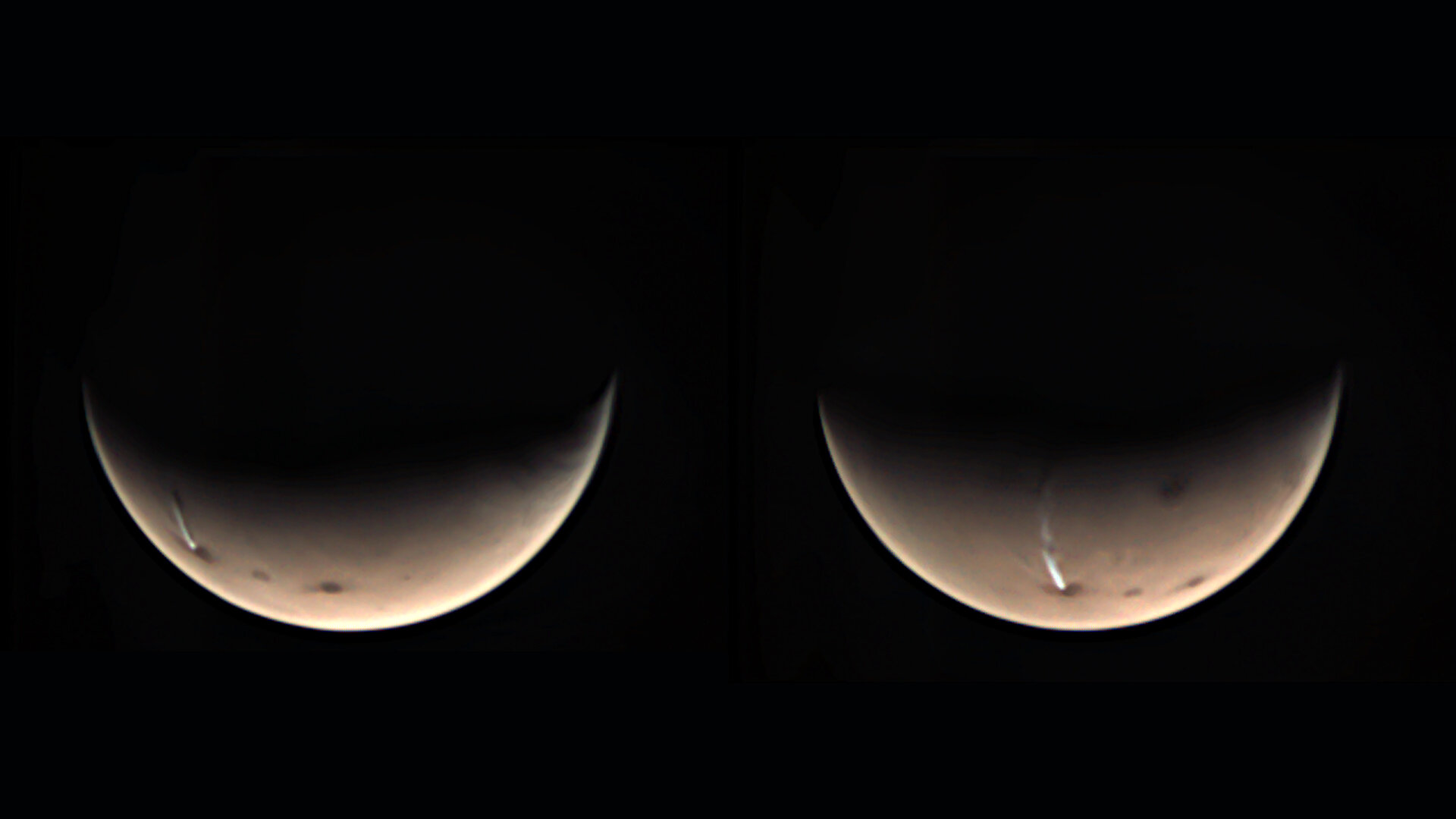The UPV/EHU's Planetary Science group has investigated the dynamics of a peculiar cloud of water ice that could be up to 1,800 km long and 150 km wide; it stretches out rapidly before fading within a few hours in a rapid daily cycle that is repeated every morning for a period of several months. This detailed study has been highlighted by the European Space Agency.
The Planetary Science group unlocks the secrets of a giant Mars ice cloud
The ESA has highlighted the detailed, long-term study carried out at the UPV/EHU-University of the Basque Country and made possible by new observations from the Mars Express probe
- Research
First publication date: 09/06/2021

When spring arrives in southern Mars, a huge cloud of water ice emerges near the 20 km-high Arsia Mons volcano. At its largest extent, the cloud is about 1,800 km long and 150 km wide. It forms when the volcano acts as an obstacle to the wind; air is forced up its flanks and carries moisture which, on cooling, eventually forms what is known as an orographic cloud; the peculiarity of this orographic cloud is that once formed, at a height of 45 km, the wind carries it along causing it to expand rapidly at a speed of about 600 km/h; so in just 2 or 3 hours, the largest orographic cloud ever seen on Mars is formed. The cloud undergoes a rapid daily cycle that repeats itself every morning over a period of several months. It starts growing before dawn, expands rapidly, then stops expanding, breaks away from its original location and eventually evaporates in the latter part of the morning when the rising sun causes air temperatures to increase.
That is the cloud’s daily cycle, discovered by researchers belonging to the UPV/EHU’s Planetary Science Group in collaboration with researchers from other countries; it was discovered by combining the images taken by several cameras, featuring new observations made using a small camera on board the ESA Mars Express probe, a long-running Mars exploration mission in orbit since 2003. The detailed study of the dynamics of this peculiar cloud has been highlighted by the European Space Agency.
The cloud is difficult to observe in its entirety because of the rapid changes in the dynamics of the Martian atmosphere and the limitations in the orbit of many spacecraft. "To overcome these obstacles, we are using one of the Mars Express instruments: the Visual Monitoring Camera (VMC),” said Jorge Hernández-Bernal, predoctoral researcher in the Planetary Science Group and lead author of the study.
Repurposing a webcam
This instrument, dubbed the Mars "webcam", has a resolution similar to that of a standard 2003 webcam; however, this work has demonstrated a very interesting and unanticipated use of the VMC, as the camera has not been used for scientific research in recent years. "Although it has a low spatial resolution, it has a wide field of view, which is essential for obtaining a better perspective at different times of the day, and it is great for tracking the evolution of a specific phenomenon over a long period of time and at short intervals. That has enabled us to study the entire cloud over numerous life cycles," added the researcher.
The research team has combined observations from the VMC camera with those from two other Mars Express instruments and from other spacecraft, and even observations made in the 1970s. The high-resolution cameras on Mars Express have narrow fields of view and observations are always planned in advance. That way, weather phenomena —which tend to be unpredictable— are usually detected by chance. However, once researchers had begun to understand the life cycle and annual patterns of this elongated cloud, they were able to guide the other high-resolution camera equipment to the appropriate location and at the right moment to capture the cloud as it emerged.
"Many Martian orbiters cannot even observe this part of the planet's surface until early afternoon, due to the characteristics of their orbits, so this is the first detailed exploration of this interesting phenomenon, something possible not only thanks to the diversity of the Mars Express instruments, but also to its orbit," explained Agustín Sánchez-Lavega, a UPV/EHU professor, co-author of the study and VMC science team lead. "Although orographic clouds are frequently observed on Earth, they do not attain this enormous length nor have such changing dynamics. Understanding this cloud gives us an excellent opportunity to try to replicate its formation with models that will improve our knowledge of climate systems on both Mars and Earth," he concluded.
Further information
Jorge Hernández-Bernal graduated in Physics at the University of Salamanca and did a Master's degree in Space Science and Technology at the UPV/EHU. Right now, he does research in the UPV/EHU’s Planetary Science Group where he is writing up his PhD on the climate of Mars through the study of various meteorological phenomena on the planet; the group is led by the Professor of Applied Physics and astrophysicist Agustín Sánchez-Lavega.
Bibliographic reference
- An Extremely Elongated Cloud Over Arsia Mons Volcano on Mars: I. Life Cycle
- Journal of Geophysical Research
- DOI: 10.1029/2020JE006517



